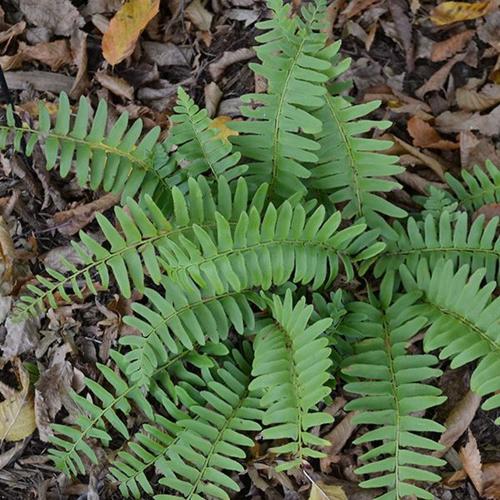Christmas Fern A Legacy of Resilience
Polystichum acrostichoides (Christmas Fern) demonstrates the enduring nature of North American native plants through their persistent existence. This species has survived for hundreds of years in eastern North America, where it originates from primeval forests which once dominated the region. Its distinctive features earned widespread appreciation from indigenous groups and early colonists as well as scientists which resulted in its widespread use for both utility and decoration.
European explorers who conducted botanical studies during the early colonial period first documented this species in the 1700s and observed its ability to survive severe winter conditions. Despite harsh winter conditions that destroy many plant species this evergreen beauty stays vibrantly green throughout the year bringing a unique burst of life to bleak winter scenes. Its adaptability and resilience have allowed it to occupy forests, rocky slopes and shaded woodlands consistently which secured its historical significance in ecology and gardening.
Christmas Fern Medicinal Significance Through the Ages
Christmas Fern holds a vital yet understated position in herbal medicine across many centuries. The original discoverers of Polystichum acrostichoides' medicinal properties were Indigenous communities who used different parts of the plant to treat sickness. Healers made teas and poultices from the fronds because they trusted these preparations helped with breathing difficulties and stomach problems.
Medical practitioners in various areas treat wounds and insect bites by applying leaf extracts from this plant to decrease inflammation and prevent infections. Early settlers embraced similar techniques after discovering the plant's natural medicinal benefits during periods when pharmaceutical treatments were limited. Modern medicine has moved past these traditional uses but plant-based remedy research has sparked new interest in the plant’s historical applications. Natural healing practices currently include this method especially among communities who prefer holistic and plant-based medical treatments.

Landscape Applications: A Shade-Loving Staple
Landscape designers and gardeners choose Polystichum acrostichoides because it offers both durability and minimal upkeep while flourishing in shadowy outdoor spaces. Polystichum acrostichoides thrives across different environmental conditions which makes it suitable for both garden enhancements and restoration projects.
This plant functions as ground cover in shaded areas because many other plants fail to establish themselves there. Woodland gardens gain depth and texture through the elegant contrast between acrostichoides' deep green foliage and flowering perennials and deciduous plants. This plant functions as a slope soil stabilizer that prevents erosion while simultaneously adding to the terrain’s natural attractiveness.
In native plant restoration projects this species finds widespread application outside residential gardens especially during reforestation work where preserving natural biodiversity stands as the main goal. This plant thrives alongside many different plants which enables it to naturally fit into both untamed and managed environments.
Christmas Fern A Striking Appearance in All Seasons
The standout characteristic of Polystichum acrostichoides lies in its unique foliage which attracts attention. The arching arrangement of its fronds generates a lush layered appearance that adds elegance to shaded landscapes. The leaflets maintain their deep green color all year and have a mildly leather-like texture.
When winter arrives and all other plants fade away the hardy fronds of this plant stand tall demonstrating their ability to withstand winter conditions. The delicate springtime fiddleheads unfurl from their tightly coiled state into graceful full-grown fronds. The plant's ongoing renewal cycle enhances its appeal to garden enthusiasts who seek constant visual interest throughout the year.
A Haven for Rare and Beneficial Wildlife
Christmas Fern serves as an essential support system for diverse wildlife species while thriving in its native forest environments. Its evergreen leaves serve as essential winter shelter for various species when other plant cover becomes limited.
Moth and butterfly species choose to deposit their eggs beneath the fronds which secures their offspring in sheltered surroundings. Ground-dwelling birds and small mammals utilize the cover to protect themselves from predators. The plant's understory presence improves surrounding plant health through soil enrichment and biodiversity promotion.
The plant draws beneficial insects to garden settings which help control pests and support pollination activities. The plant supports year-round wildlife presence which makes it essential for conservation landscapes and naturalistic gardens.
Christmas Fern Hardy and Adaptable in Challenging Conditions
The most notable characteristic of Polystichum acrostichoides involves its robust hardiness. Polystichum acrostichoides survives in multiple climates including the humid forests of the southeastern United States as well as the colder woodlands of the northeast and areas throughout Canada. Polystichum acrostichoides survives freezing temperatures which makes it a dependable option for winter gardens in cold regions.
Polystichum acrostichoides show a preference for well-drained organic-rich soil yet successfully grows in diverse conditions such as rocky slopes and clay-rich earth. The plant needs little maintenance after initial establishment, which makes it perfect for anyone who desires a durable and independent plant species. This shade-loving species stands out because it remains free from diseases and pests which enhances its reputation as both low-maintenance and valuable for landscaping.
The ability of these plants to survive for many years serves as proof of their durability because they expand and preserve their full appearance with minimal care. Maintain its shaded or partially shaded environment with enough moisture and the plant will keep beautifying its surroundings for decades to follow.
Conclusion
Polystichum acrostichoides demonstrates both subtle power and lasting visual appeal. A species with a deep-rooted history from ancient botanical records demonstrates its ability to persist through time while delivering practical uses and visual appeal. The plant demonstrates essential value across natural and cultivated environments through its medicinal properties and support of wildlife habitats and shaded landscape design.
The combination of beautiful fronds and durable nature along with biodiversity enhancement makes Christmas Fern an essential part of North American plant life. Native plants demonstrate their understated strength by sustaining crucial ecosystems which gardeners and conservationists depend on for natural balance.